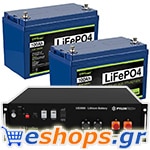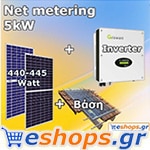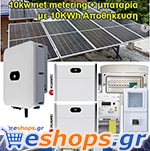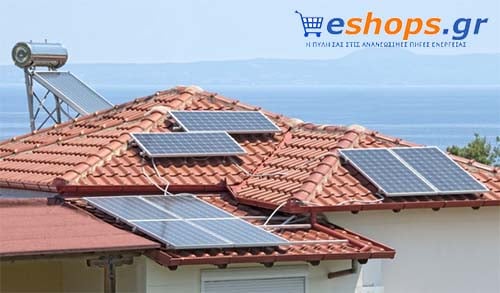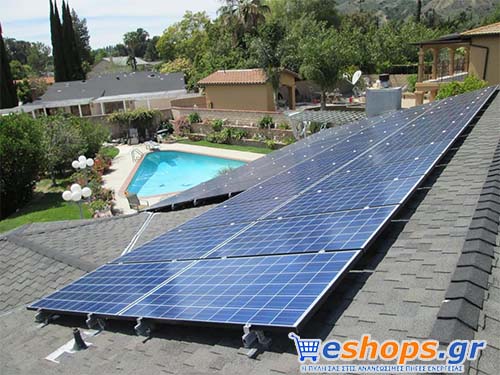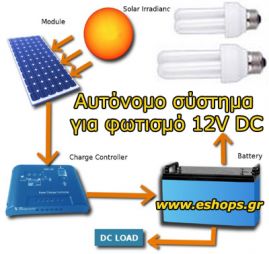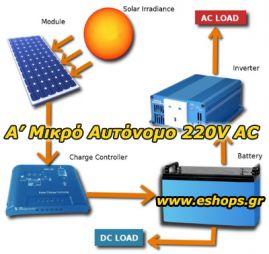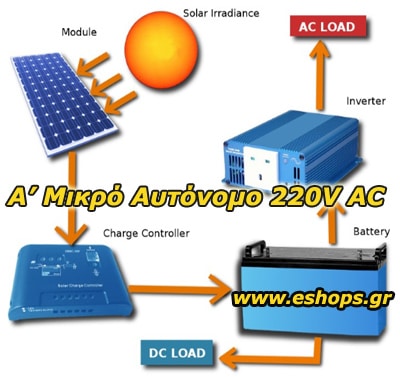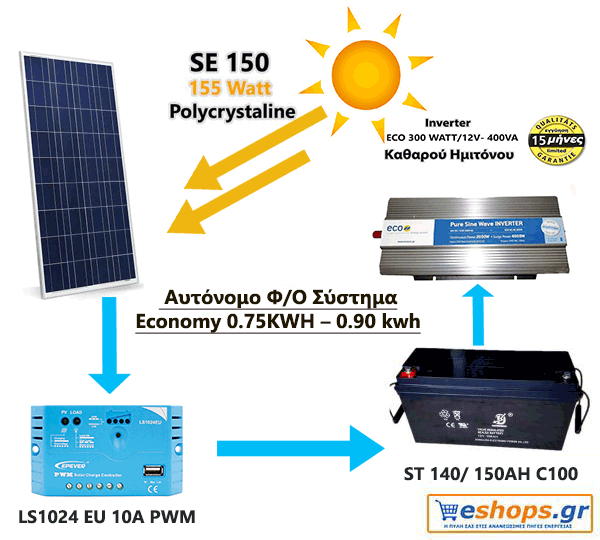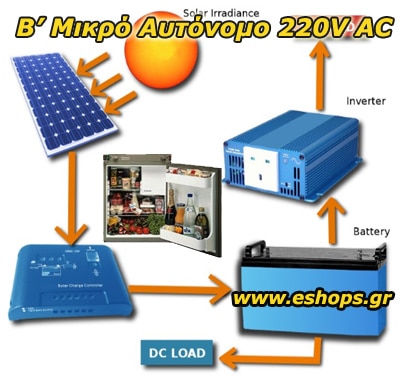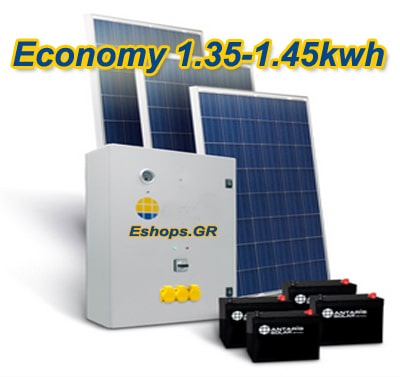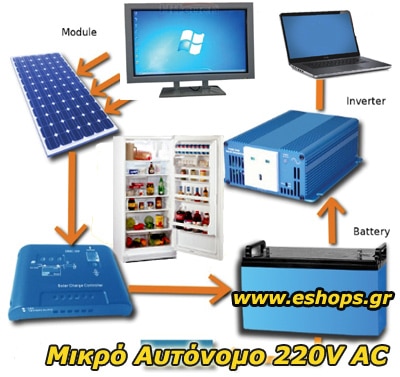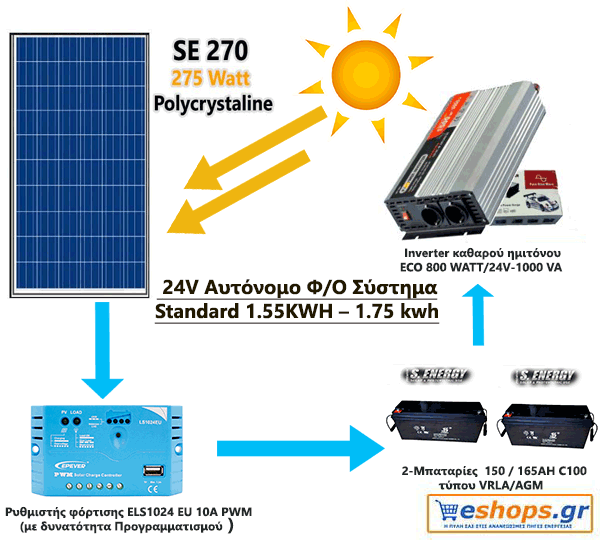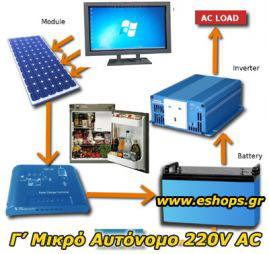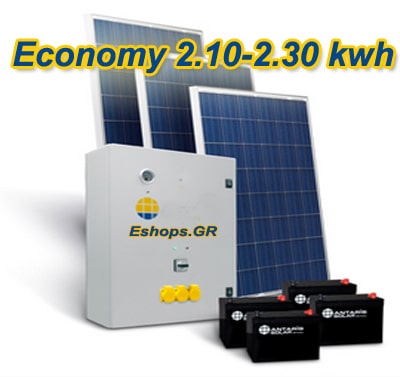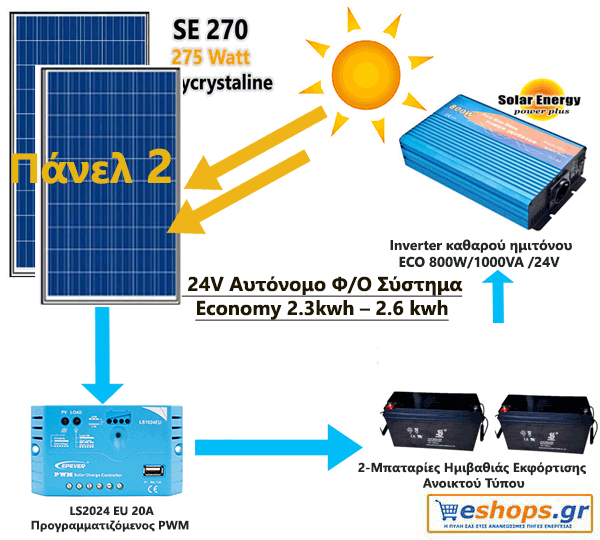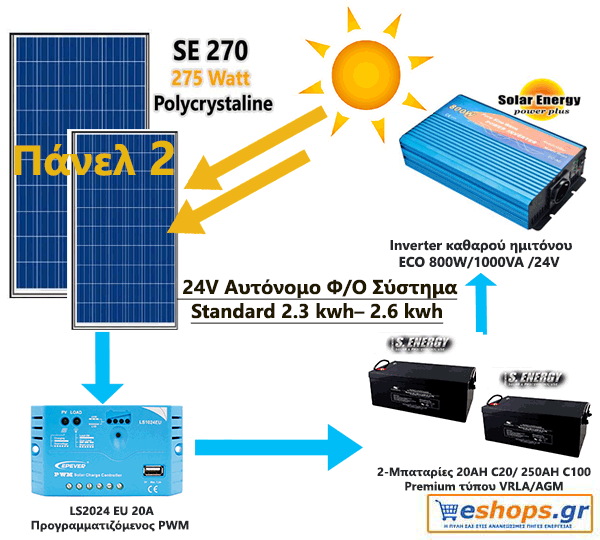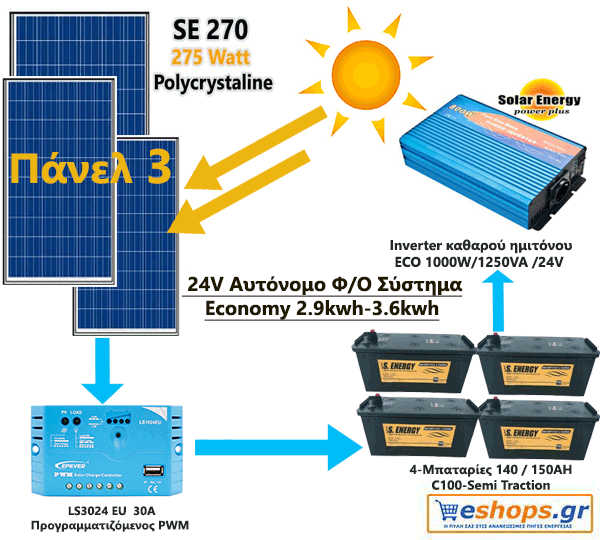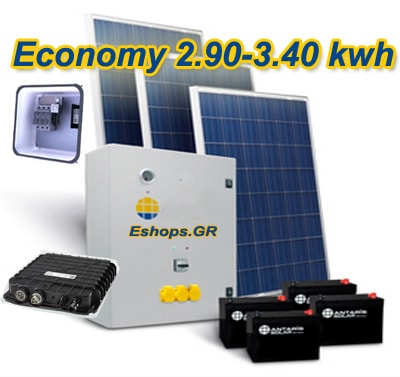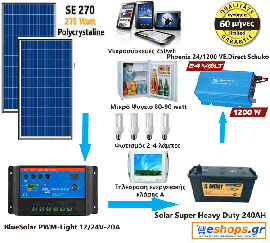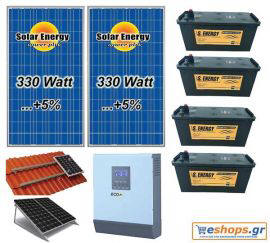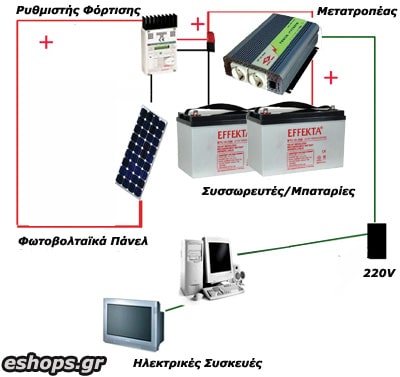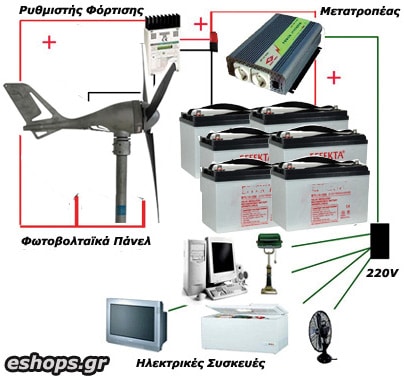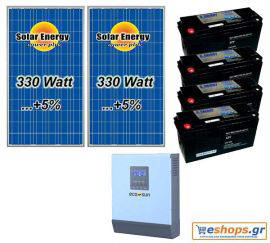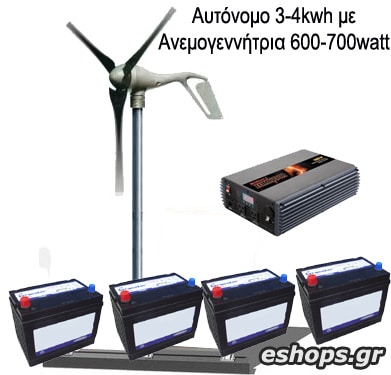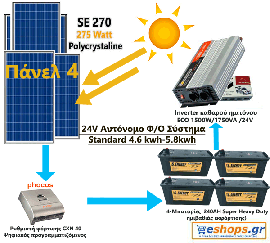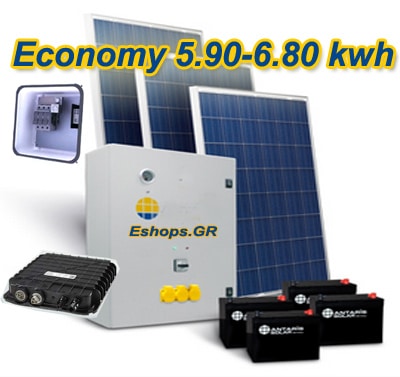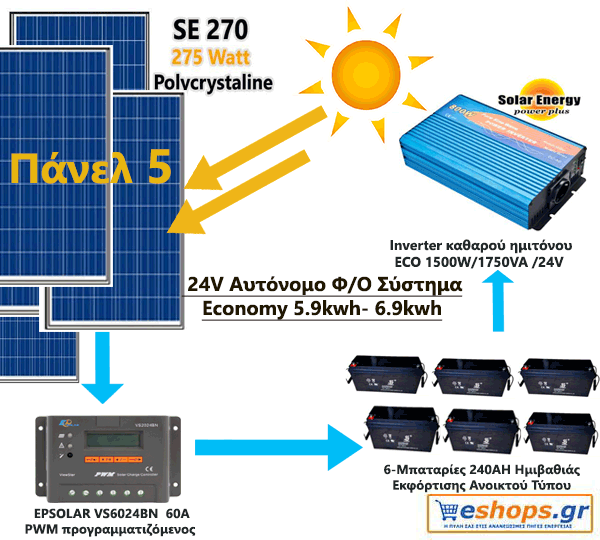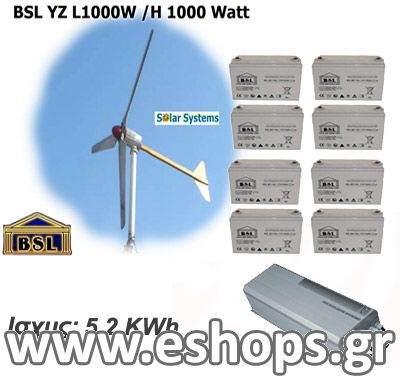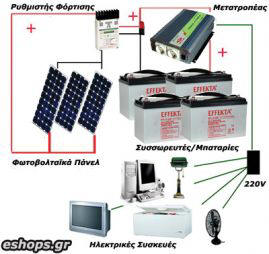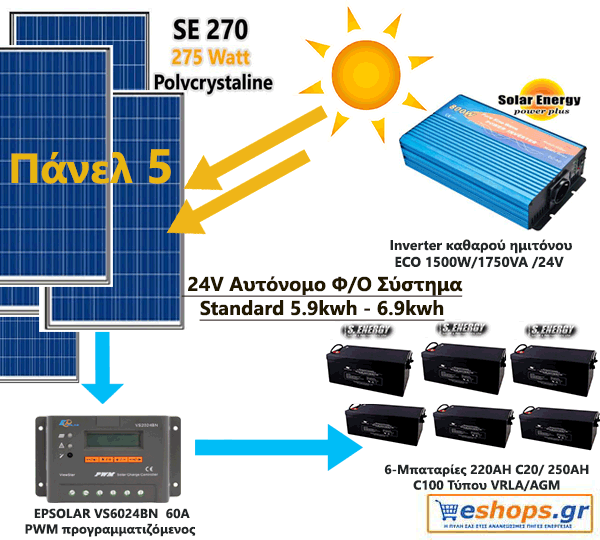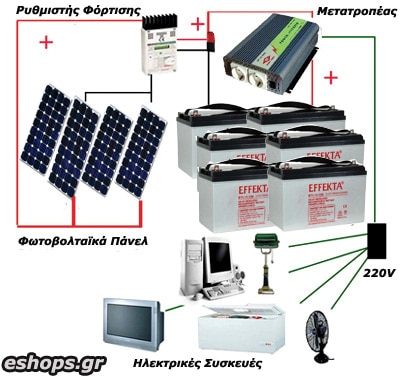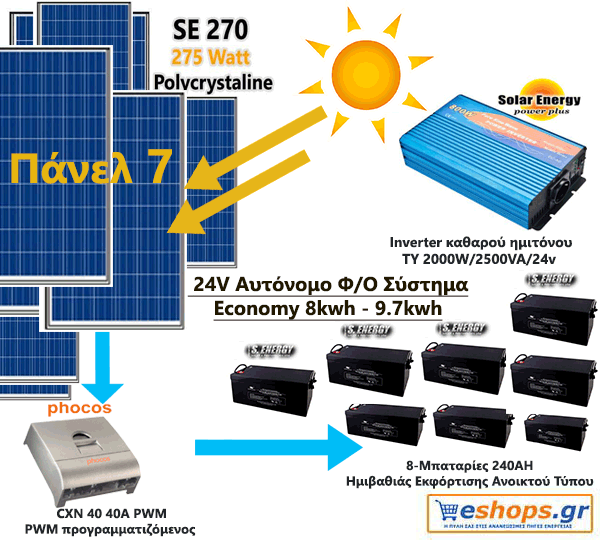Autonomous photovoltaic packages
The new Autonomous photovoltaic packages of eshops.gr, ensure the necessary conditions for the electrification of a cottage ή permanent residence. Providing energy that is essentially free from the sun can provide solutions to all your energy needs. photovoltaic packages we include all the necessary equipment, in Solar panels, deep discharge batteries, inverter, Charge Controllers cables, fundamentals .
AUTONOMOUS PHOTOVOLTAIC SYSTEMS FOR A COUNTRY HOUSE |
AUTONOMOUS PHOTOVOLTAIC SYSTEMS FOR PERMANENT RESIDENCE |
Autonomous photovoltaic packages In real estate, country houses or permanent residences as well as in professional areas (hotels, businesses, crafts or industries that are already interconnected with the PPC network, the creation of an interconnected photovoltaic energy compensation system is proposed as a more economical option for saving net metering See information…
How the photovoltaic system works and how to calculate it in your own case.
Here's a series of articles that explain how an autonomous photovoltaic system works and the best way to design and cost your own photovoltaic system.
Before designing and purchasing one photovoltaic system, remember energy conservation and good home planning play an important role in reducing the size and cost of an autonomous photovoltaic system. The use of energy-efficient appliances and lighting, as well as non-electrical alternatives, where possible, can make an off-grid solar or wind-based photovoltaic system a cost-effective solution to the grid. Generating backup generators for part of the day can also help reduce and offset photovoltaic installation costs.
Some hours of sunshine per day, days of autonomy and average energy consumption at home will determine the size and ultimately the cost of each solar photovoltaic system.
Free production of electricity from sunlight (photovoltaic)
Autonomous photovoltaic packages: Photovoltaic system and how to calculate it in your own case
AC is of course suitable for the most common 240 VAC appliances, washing machines, power tools, large screen TVs and game consoles, microwave ovens, toasters, etc. Cordless phones and answering machines, clock radios and alarms, cell phone chargers or Ni-cad batteries need power on a full basis.
When you install a non-renewable renewable energy system (ie one that is not connected to the local utility network) for your home, you become your own power company, so every kWh (kilowatt hours) of energy you use means more solar equipment (and therefore more money) is required to meet your energy needs.
Autonomous photovoltaic packages: The preparation for any photovoltaic system begins with the assessment and calculation of your energy needs. The main tool used for this task is a "load list". A charging list is simply a combination of all the electrical charges that will be used in the integrated system and includes all the electrical charges that will be used in the home offline, such as: light bulbs and lights, TV and game consoles, microwave ovens, chargers, etc. , should all be included in your list.
Typical example of solar energy
Autonomous photovoltaic packages: The amount of solar energy that reaches the Earth is typically about 1.000 Watts per square meter (1.0kW / m2). This amount of sunlight varies considerably depending on the location and the time of year. Recording this solar energy requires equipment and systems with relatively high initial capital costs. However, throughout the life of solar equipment, these systems can prove cost-competitive compared to conventional energy and fuel combustion technologies.
The key to successful installation of the photovoltaic system is the use of quality components that have long lives and require minimal maintenance.
Autonomous photovoltaic packages: Photovoltaic system and how to calculate it in your own case.
Load list - Calculation for home system photovoltaic
Loading name Power in watts “ON” Watt-hours All lamps, General (fluorescent) 150 6 900 Lighting fixtures, living rooms (fluorescent) 100 6 600 Lights, 4 beds / 2 baths (fluorescent) 240 4 960 Lighting Fixtures, Kitchen / Units (Fluorescent) 80 4 320 TV 40 ", Living Room 140 6 840 TV 32", Bed 90 4 180 Satellite / Video / Consoles 60 12 720 Computer / Laptop / Hubs / Routers 350 4 1400 Washing Machine (A-rated) 500 0.3 150 Refrigerator / Freezer (A-rated) 75 12 900 Toaster 1200 0.1 120 Microwave oven (750W) 750 0.1 75 Kettle 1200 0.1 120 Vacuum cleaner 700 0.1 70 Iron 1000 0.1 100 Miscellaneous (Power tools etc.) 300 1 300 PART TOTAL 7,755 10% loss 775 Total at home 8.530 watt-hours kWatt-hours / day 8.53 kWatt-hours / month 256 Cases made:
Number of Houses: 4
Number of bedrooms: 4
All lights and bulbs use energy efficient compact fluorescents
Any appliance used for heating and cooking, such as electric water heaters, hobs, central heating boilers and air conditioners, are expensive loads to run on solar energy and should be avoided. For cooking you should consider using alternatives such as LPG or propane gas. Use solar water heating for water and space heating and evaporative cooling as well as passive solar design in your home construction, if possible, instead of air conditioning units with compressor.
Autonomous photovoltaic packages: Consider using energy efficient lighting. Replace a 60 watt incandescent light bulb that operates 6 hours a day with a compact 13 watt fluorescent lamp. This would save about 282 watts-hours each day with the same extra power available each day adding another 48-watt photovoltaic panel. Changing bulb over cost would be about £ 1 to £ 2 was as added panel costs
Notice that these 282 watt-hour savings are earned every day the lamp is used. On sunny days, when an extra panel would give the same amount, but the new lamp also saves 282 watts on sunny days when an extra panel would do little or nothing. This is why maintaining design is VERY important from the energy source itself.
Evaluate the solar potential of your site
Autonomous photovoltaic packages: The amount of energy you can get from a photovoltaic system to the off-grid depends on your location and the time of year. Generally, you can expect to get more sunlight between April and September and have a clear sun exposure for most of the day, e.g. from 9am to 3pm.
Measuring the resistance of sunlight hitting the earth in your place is defined as sunshine. Using this value, you can determine how much solar energy you can generate throughout the year for your site. A sunscreen map can help you find the minimum solar power system (photovoltaic system) required during the off-season with the shortest amount of sunshine for your location.
Autonomous photovoltaic packages: Photovoltaic system and how to calculate it in your own case.
Monthly average sunshine induced by solar radiation in Tarragona, Spain (kWh / m2 / day) Reference: http://eosweb.larc.nasa.gov
Once we have found the solar sunshine for a particular location, we need to divide the estimated daily energy consumption (kilowatt hours) by the worst case of solar sunshine from the graph and multiply it by a system inefficiency factor of 1,3 (30%) for a system solar power that is off-grid.
The estimated daily usage was 8,5 kWatt-hours per day.
Total power of the solar panels = [(Daily kilowatt hours) / (solar sunshine)] x Deficiency factor
Jan February Marc Apr May June July Aug Sep Oct Oct Dec 4.0 2.75 1.98 1.58 1.42 1.38 1.46 1.68 1.98 2.64 3.71 4.63 4,63 The worst month for the most solar energy is December at 4.63 kWatts. Then we need a 4.630kWp (or 8.5 Watt) system in order to produce an average of 5.39kWh per day for our location with an average of XNUMX hours of sunshine.
Now that we know the total power of the array of solar panels, we can choose the specific solar panels that will be this total power. Note that this power is 100% off-grid. If there is electricity or it is connected to the house, this value can be reduced to give a percentage of the solar energy required to supply the house with electricity. For example, solar 25%, 50% or 80% etc.
Autonomous photovoltaic packages: Selecting the required solar panels
We already have an accurate idea of the sunshine for a particular location. We have done load list research to know how much electricity we require in an average day. All that remains is to determine the type and number of photovoltaic panels (PV) that will produce the required power of 4,6 kWatts.
We consume an average of 4.630 Watt-hours of energy daily. Then dividing the power consumption by the average output of a single panel will give us the number of frames required.
Photovoltaic system and how to calculate it in your own case
Volt 4630W Panels Req required. Power Panel 120W 40 140W 34 200W 24 240W 20 Solar panels can vary in type, size, shape and voltage. In most cases the size of a photovoltaic panel refers to the rated output power of the panel or to the generating capacity. Solar panels can also have different voltage values depending on their size. Those with 12 to 48 volts are generally used for off-grid applications. The maximum power (P) delivered by a panel is given as voltage (V) x current (I).
Autonomous photovoltaic packages: Individual solar panels can be combined into larger arrays, connecting them in a fixed combination to achieve the required voltage or rated current. The following tables show possible array combinations for the number of frames required to supply a minimum of 4.630 watts.
AKT-120-M Solar panel
Power in watts: 120W Size: 1182x808mm Voc: 21.6V Isc 7.54Α Quantity: 40 Weight: 10 Kg Vmp: 17.5V Devil 6.86Α
Combination of panels Voltage (V) Current (A) Power (P) Area (m2) Weight (Kg) 1 x 40 17.5 274.4 4802 38.2 400 2 x 20 35.0 137.2 4802 38.2 400 4 x 10 70,0 68.6 4802 38.2 400 5 x 8 87.5 54.9 4802 38.2 400 8 x 5 140,0 34.3 4802 38.2 400 10 x 4 175,0 27.4 4802 38.2 400 20 x 2 350,0 13.7 4802 38.2 400 40 x 1 700.0 6.9 4802 38.2 400 Array data 120W:
Quantity: 40 Panel Price:
Table area: 38,2 m2 Array Price:
Array Weight: 400 Kg Cost per Wp:
Photovoltaic system and how to calculate it in your own case
Combination of panels Voltage (V) Current (A) Power (P) Area (m2) Weight (Kg) 1 x 34 17.5 272,7 4772 40.3 482,8 2 x 37 35.0 136.3 4772 40.3 482,8 17 x 2 297,5 16.0 4772 40.3 482,8 34 x 1 595.0 8.02 4772 40.3 482,8 140W Table data:
Quantity: 34 Panel Price:
Table Area: 40,3 m2 Array
Array Weight: 482,8 Kg Cost per Wp
Combination of panels Voltage (V) Current (A) Power (P) Area (m2) Weight (Kg) 1 x 24 55.8 86.2 4808 27.9 360 2 x 12 111.6 43.1 4808 27.9 360 3 x 8 167.4 28.7 4808 27.9 360 4 x 6 223.2 21.5 4808 27.9 360 6 x 4 334.8 14.4 4808 27.9 360 8 x 3 446.4 10.8 4808 27.9 360 12 x 2 669.6 7.2 4808 27.9 360 24 x 1 1339.2 3.6 4808 27.9 360 240W Table data:
Quantity: 20 Panel Price:
Array Area: 32,9 m2 Array
Array Weight: 420 Kg Cost per Wp
Autonomous photovoltaic packages: Looking at the above data, it is clear that the 250 Watt 24 Volt solar generator will be the option of choice that offers a better cost per peak watt (Wp). This gives a range of only 20 solar panels at a cost (excluding accessories, etc.) per square meter with an array area of 33 m2.
System voltage selection
Photovoltaic system and how to calculate it in your own case
Autonomous photovoltaic packages: Depending on the power of the panel and the combination of arrays, there are a number of voltage and current configurations that we have to supply the house with direct current power.
All solar systems with batteries as a backup should include a solar charge controller to prevent the batteries from overcharging and also to prevent the batteries from sending their charge back to the solar panels during low sunshine (ie at night). ).
Since a solar controller does its job between the solar panel and the batteries, it makes sense that the selection and sizing are influenced by these components. Voltage and current are the two parameters used in the solar charge size controller. The solar controller must be able to accept the maximum power generated by the solar panels while generating the appropriate DC voltage and charging current in the batteries.
12 or 24 volts is the most common standard for an off-grid alternative home, mainly because it is already a conventional standard. As we move to higher voltages, fewer currents (amperes) are required to supply the same amount of power (watts). Efficiencies also tend to increase with higher voltages and lower currents because a higher voltage array reduces the voltage drop across long cable distances.
For low voltage - high voltage systems, long cables between frames or inside buildings can be very expensive at the cost of cables the greater the distance, the larger the cable diameter in mm2, power losses must be reduced . So by reducing the current by half using the double voltage we can cut the cost of cables used to connect the rated DC solar panels.
From the table for the 250 watt panel, the lowest voltage is that of a single 24 volt panel, but the current supplied is the highest at 157,8 amps as the 20 panels are connected in parallel. This high current price would require very large and expensive cable routes making it unsuitable.
A lower rated voltage of 7,9 amps would allow the use of a normal lighting cable, but the voltage provided by the series battery is very high at 596 volts. Too big for batteries. A much better alternative would be a combination of 2 x 10 of 20 panels. This would give an output voltage of 48 volts (2 x 24) which provides a current of about 80 amps (10 x 7,89).
2 tables in 10 line configuration
The rated voltage throughout the system, the photovoltaic generator, the solar charge regulator and the battery bank is now set at 48 volts (Voc = 73,8 volts max).
The next step in charging the size of the charger is power. For continuously operating systems, additional protection must be included. The industrial factor of 1,25 de-rating is set to prevent damage to the controller due to excessive current or power from the solar panel.
The maximum short circuit current of the Kyocera KD-240 panel is given as 8.55 Amperes. Next, the maximum current generated including the de-scoring factor for an array of 10 strings is given as:
Arrangement Isc = (10 x 8.55) x 1.25 = 106.8 Amperes
This value of 106,8 amps can be too high to use a single charge controller. Therefore, the device may need to be split in half (2 × 5) + (2 × 5) and connected to two separate controllers while generating the required system voltage on the batteries. Therefore, each solar charge controller should have a minimum rating: Voc = 74 volts, Isc = 55 Amps.
Each smaller panel consists of 10 solar panels each in a combination of 2 × 5 2.400 Watt (2.4kWp). Two possible basic PWM solar controllers are:
1. The Tristar TS-60 has a rated system voltage of 48 volts at 60 amps (maximum value 150V),
2. nominal system voltage Xantrex C60 48 volts at 60 amps (maximum 125V),
Standalone photovoltaic kits: Note that there are other types and manufacturers that could also be used. Even if they can control the battery and the battery charge is better 3 to 4 times the value of the two above.
Maximizing the Deep Circuit Battery Bank of the Photovoltaic System
Unfortunately, the sun does not always shine, especially at night, so some extra backups. During a nice sunny day, the solar panel can generate a lot of electricity, so you will need batteries to access this power after sunset.
The amount of sunlight available during the day depends on the location and the time of year which affects the time of sunrise and sunshine. Generally during the winter season this can be as low as 5 hours or up to 8 hours during the summer season. It is typically used for an average of about 6 hours a day.
Example of solar energy available during a day.
Photovoltaic system and how to calculate it in your own case
Then, in order to be able to use this power at any time, night or day, we will need storage batteries, especially large cycle batteries for 100% off-grid.
Deep circulation batteries
Deep circuit batteries used in solar renewable energy systems are different from car batteries. Electricity is captured and stored, and then consumed later, in a regular cyclical manner throughout the day. For example, in a battery-based renewable energy system, whether solar, photovoltaic or wind turbine, the energy produced daily is stored in a battery bank, which is then used to power household loads - all sunny days .
This repetitive process puts the batteries in a long slow, daily charge and discharge cycle, where the shallow circular car batteries on the other hand with their smaller, thinner plates are designed for quick, short start-up of the engines.
Deep cycle batteries are only 2 volts each, so to use them in a 48 volt system, we will need 24 cells connected in series (2 × 24). There are multiples of 2 volts cells, ie 4V, 6V and 12V. Also, these batteries are large, very heavy and give off gases when charging, so additional equipment and space is required to handle such large batteries.
The amount of power consumed per day in the home was estimated at 8.530 Watts before using the information in the "load list". This is the minimum storage capacity we need for one day. Next, we need to determine the number of backup battery days we want to have at your disposal. This is called "Autonomy".
Autonomy Days represents the number of cloudy days in a row that can occur and for which batteries should power the home. A typical number of autonomy days is usually 3 days. Then, the total amount of energy required for at least three (3) days of storage for our 4-bedroom home that consumes 8.530 watts-hours daily is calculated at:
8.530 x 3 = 25.600 watt-hours
Since the deep-circuit battery is lead-acid, we must divide this value by 0,8 to maintain a 20% stock on the batteries after the 3-day discharge period to ensure that the batteries are not completely discharged to zero. This is calculated as follows:
25.600 ÷ 0.8 = 32.000 watt-hours
If we divide this percentage by the voltage of our system in 48 VDC, we reach a capacity of lead-acid battery cells:
32.000 ÷ 48 = 667 Amp-hours
or 222 ampere-hours of battery life per day.
Now that we know the Amp-hour (Ah) capacity of the battery bank that will give us the storage capacity we need, we can now choose a specific deep circulation battery. The required deep circulation batteries must meet both the system voltage requirements and the Ah capacity calculated above. For the 4-bed house using a 48V system, we calculated that we needed 667 Ah to produce 8.530 Whr per day with 3 days of storage.
Suitable deep cycle storage batteries are:
1.2v Solar 6 OPzV 720 which is a 720 A / hr battery of 2 batteries (single cell),
2. Rolls Solar 5000 - 6 CS 17PS which is a 6 Volt battery (3 cells) 770 A / hr, with price: £ 976
3. Exide Classic - OPzS-765 which is a 765 A / hr battery of 2 batteries (single cell), with charge: £ 418
The 2nd battery above, the Rolls Solar 5000 - 6 CS 17PS is a 6-volt three-cell battery, so only eight are required to deliver the 48 volts (6 × 8). The total battery bank price will therefore be:
1. The Rolls Solar 5000 6-CS-17PS,
Clearly, a Rolls Solar 5000 - 6 CS 17PS battery with a rated power of 6 volts would be the cheapest battery option. Also, as only 8 batteries are required, less space is used and fewer connection cables, connections and terminals, reducing installation costs
Note that if the solar charge controller does not have a built-in battery monitor, you will need to purchase and install a separate battery monitor to display the voltage, current, and battery charge status indicators.
Off-grid DC to AC converter
We now have an 8,5kWhr off-grid system, which consists of 20 solar panels, a solar charger controller Tristar CS-60 and a 48-volt DC battery bank using Rolls 6-CS-17PS, 6V batteries. Unfortunately, this setting will not power your home TVs, computers, refrigerator / freezer or washing machine, etc., as these appliances need 240 VAC to operate. Then we have to convert the voltage 48 DC to 240 volts AC (alternating current) and to do that we need a converter.
Photovoltaic system and how to calculate it in your own case
All inverters convert direct current (DC) electricity to alternating current (AC) to operate AC devices. The size of the inverter required to power the home off-grid is based on requirements called "peak load" - all AC loads that could be activated simultaneously. AC converters are typically more efficient when operating at or near their peak, but most of the time the inverter will carry a wide range of loads, usually without its maximum capacity.
For the size of the required inverter we could accurately calculate all the loads that will be activated at the same time. Such as lights, TV, computer, refrigerator / freezer, etc. Ή give a percentage of mania, 5%, 10%, 30% etc. of the total daily load.
Also note that a single off-grid inverter does not need to be used to power the entire house. Separate circuits and smaller dedicated inverters can be installed to power refrigerators, freezers, dishwashers, water pumps or other major electric motors for example, but if these inverters are expected to run on induction motors, they must be suitable for overflow currents many times for short periods of time while these motors are starting.
Off-grid independent converters are available with three basic power output waveforms: Square Wave, Modified Square Wave and Pure Sine Wave. Square wave converters are the cheapest but may not work or may damage many electronic devices such as computers, printers, copiers, fluorescents and dimmers and flat screens, as well as produce background noise on radios or older TVs. Modified square wave converters are improved on this.
Autonomous photovoltaic packages: Sine-wave converters may have higher purchase costs, but they can operate almost anything that can operate at utility power as their sine wave output reproduces exactly the sine waveform of the mains supply, so it is a better choice.
Then, assuming a peak load consumption of 35%, we would require a sine wave converter to come out of a 48-volt battery bank operating at about 3.000 W, (8530W x 30%).
Suitable 48 volt, 3,000 Watt sine wave converters are:
1. Outback FX3048T which is 3000W, 48V Sine Wave Inverter,
2. Apollo Solar TSW4048 which is 3000W, 48V Sine Wave Inverter,
The Outback FX3048T is selected solely on the basis of price, but there are other types and manufacturers that could also be used.
Complete off-grid photovoltaic system
Item Description Quantity Estimated
% PV Panels 250 Watt 20 42% Solar Charging Controller Tristar TS-60 2 2% Battery Battery 48VDC Rolls Solar 6 CS 17PS 8 39% Outback FX3048T 1 5% Installation and Material DC cables, panels, mounting 1off 12% Total Estimated value of components
Backup generator
An off-grid photovoltaic system can be dimensioned to provide electricity at night or in dim clouds when the sun is not shining. But the size of a system to cover a worst-case scenario, such as several cloudy days during the winter, can lead to a very large, expensive system that will rarely get used to its full capacity.
To save on photovoltaic installation costs we could separate the system moderately, supply the lights and other basic equipment used daily but include in the system design an internal combustion engine generator to provide the extra backup power required for the supply of larger electrical loads washing machines, dryers, heaters, water pumps, etc. or during peak periods of electricity demand.
Autonomous photovoltaic packages: In addition to gasoline and diesel, generators of the combustion engine type can be powered by biodiesel, ethanol, biogas or other such vegetable oils to save costs. These generators can generate AC power to power the house directly through the AC switchboard or to generate DC power stored in batteries in the same way as photovoltaic panels. Like most internal combustion engines, backup generators tend to be loud, smoky and require a fuel storage tank, so extra space away from the main living area and regular maintenance is required.
Autonomous photovoltaic packages: The generator allows the photovoltaic source to be smaller in size for average daily consumption and not for higher peak consumption. One of the main problems with this off-grid setting is that if the photovoltaic panels, solar charge control or inverter failed or the system had to be switched off for any reason, the house would be without electricity during this period. Next, any backup generator must be able to supply all the housing requirements plus an additional amount for the motor starting wave currents.
In our outdoor house with 4 beds above, we estimated that the power consumption would be around 8.530 Watt or 8.5 kW. The generator must be large enough to handle this continuous load kW and the worst case load. Assuming an additional 10% surplus and rounding to the nearest kilowatt, a 10 kw (10kW) single-phase generator would be needed to power the house 100%.
Suitable diesel generators identified are:
There will be additional installation costs and wiring costs to connect the generator to the switchboard or converter switchboard.
Autonomous photovoltaic packages: Photovoltaic system and how to calculate it in your own case

















